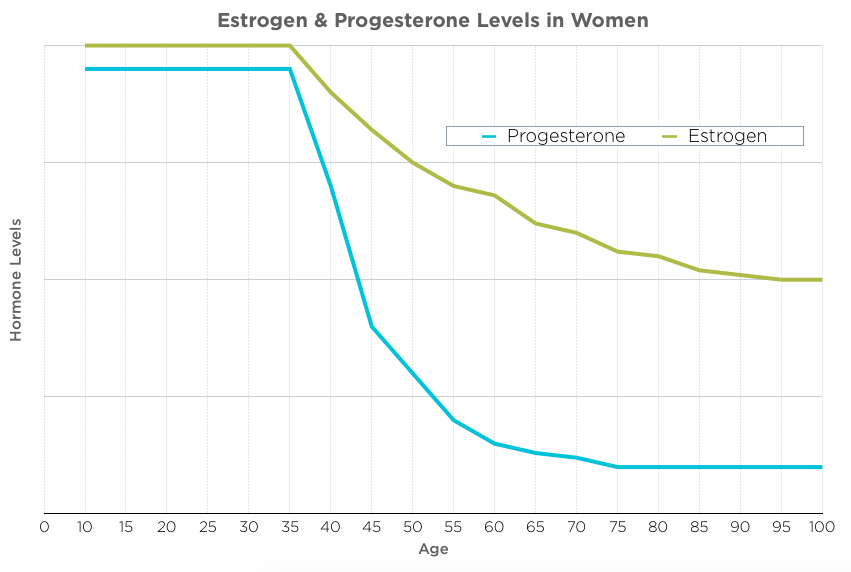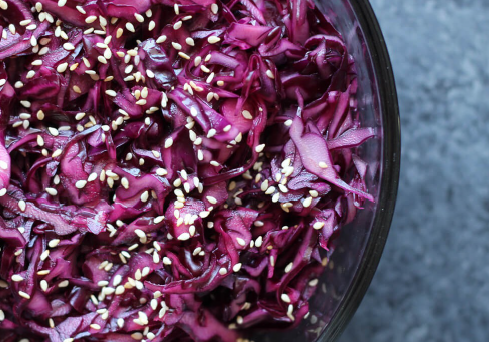
It takes two to tango as they say and that’s really the story of estrogen and progesterone – two important hormones that work in balance and are part of the delicate dance of fertility, perimenopause, healthy libido and general vitality.
And yes, men, listen up: you too produce estrogen and progesterone (which is a precursor to testosterone) so it’s also important for your good health.
So this week – we go with E for Estrogen and more specifically, Estrogen Dominance.
The role of estrogen in the body
Estrogen is a feminine hormone that is required for reproduction, cardiovascular health and it also promotes new bone growth. Your body makes three main types of estrogen: estradiol which is the most common type in women of childbearing age; estriol, the main estrogen during pregnancy; and estrone which is the only one a post-menopausal body will make.
Estrogen is critical to help women have good heart health as it helps increase HDL (the ‘good’ cholesterol) and lower LDL (the ‘not good’ cholesterol), as well as smoothing and relaxing the blood vessels so that blood flows more easily. It also sops up free-radicals, those oxidizing particles that can damage arteries, cell walls and other tissues. Some studies also say that it may promote clot formation – which is less positive. The reduction of estrogen is one reason why the risk of heart attacks and heart disease increases in women who are post-menopausal.
From a reproductive perspective, estrogen’s role is to lay down the lining of the uterus. This happens between days 1-14 of a typical 28-day cycle (day 1 is the first day of menstruation). This laying down of the lining is preparation for the body to conceive.
Remember, the body and our hormones are all about survival, including survival of the species, so in addition to lining the uterus, estrogen also tells a woman’s body to ensure it has adequate fat stores in order to nurture a pregnancy. Estrogen is what begins breast tissue production at puberty. It broadens the hips and gives women their curves, all in preparation for childbirth whether or not conception happens. Ahhh estrogen – such an optimist!
What happens when there’s too much estrogen?
An overabundance of estrogen will promote fluid retention and for women who are still in their reproductive years, this can lead to PMS, bloating, breast tenderness, puffy ankles, hands, and face as well as tight waist bands as fluid accumulates around the middle.
Too much estrogen can also make us crabby and sad. Why? Because it then overpowers progesterone, the other critical reproductive hormone, which is a powerful and natural anti-anxiety and anti-depressant agent. Progesterone is responsible for keeping that uterine lining in place during the back half of your cycle. If there is no baby-making, then your levels of progesterone fall and – voila! – you have your period.
This hormonal dance continues from the onset of menstruation – which for North American girls starts at about age 12 – until menopause, at around age 51 (although don’t quote me on these numbers… we all know someone who started their period at age 10 or 16 and who is still patiently waiting for menopause to kick in at age 58!) Yes, for most women that’s 39 years of menstruating….460-some periods, give or take a pregnancy or two.
But it’s not always smooth sailing and there are lots of factors that disrupt the balance of these two key hormones with the result of estrogen dominance. This can bring on a whole host of other health conditions and vulnerabilities, including:
- Fatigue
- Increased fat storage in the legs, hips, breasts
- Stubborn obesity – especially belly fat
- Cellulitis
- Low libido
- Heavy and painful periods
- Insomnia
- Night sweats
- Mood swings
- Anxiety
- Fibromyalgia
- Polycystic Ovary Syndrome (PCOS)
- Hormonal migraines
- Fibroids and endometriosis
- Hormone-sensitive cancers
Things can get especially tough for women over the age of 40 because as we prepare and move into peri-menopause (the 5-10 years leading up to menopause), there is a steady decline in progesterone. And yes, our estrogen also declines during this time but there are tons of factors – from the external world – that will mimic estrogen in the body or inhibit the body’s ability to clear and move estrogen out efficiently.
Key factors that lead to estrogen dominance
Estrogen dominance is complex but some of the most pressing factors include:
- A poor diet resulting in nutrient deficiencies
- Digestive issues – which put a strain on estrogen detoxification processes in the liver
- Chronic stress – which taxes the adrenals and the thyroid, the ‘helpers’ of estrogen
- Unresolved emotional issues
- Negative lifestyle habits like smoking and alcohol use
- Exposure to endocrine disrupters – xenoestrogens, oral contraceptives, environmental toxins.
Pesticides, Plastics and The Pill
Excessive exposure to toxic chemicals is definitely an endocrine disruptor – for both women and men. That’s why I caution about the use of both conventional home and body care products as well as encourage choosing organics whenever you can.
Did you know that the average woman is exposed to 515 chemicals a day and 60% of that will be absorbed into the body?! Poor liver – that’s a lot of detoxification to take care of even before it starts with food, alcohol, stress etc.!
From moisturizers, lipstick, shampoos, deodorant, dishwashing liquid, air ‘fresheners’, laundry detergents, dry cleaning chemicals, air pollution, smog, garden fertilizers, and pesticides from the bug repellents we use to the fruits and vegetables we eat — YUCK! All are toxic and when we are exposed to them – it means our liver has to work extra hard to clear them, which leaves less time for its real job of clearing excess estrogen from the body, which results in it recycling back and building up more and more of a storehouse. Parabens , touted as a ‘preservative’ are especially heinous.
Phthalates are a groups of chemicals that are added to plastics to make them pliable and flexible. And plastic is everywhere, right? Cling film, your kid’s sippy cup, the food containers you carry to pop in the lunchroom microwave, to the ubiquitous plastic water bottles (that I loathe), even down to those little plastic microbeads in body scrubs and the like. These chemicals have been linked to reproductive cancers as they are powerful disruptors of our hormonal balance, because they can mimic human hormones. They are sometimes referred to as xenoestrogens (xeno = foreign). Their power to disrupt comes because they are so similar in structure to real hormones that they can bind to the hormone receptor sites on our cells and do real damage!
And this is not just an issue for women. Every heard of (or seen) ‘man boobs’? Gynomastia is a sign of estrogen dominance in men. So is erectile dysfunction.
Food additives in processed foods, like those used to prevent fats from spoiling or seafood from discolouring, can also mimic estrogens.
And one of the biggest endocrine disruptors is the birth control pill. Think about it: it’s a combination of synthetic estrogen and progesterone designed to alter your own natural hormone cycle. What did you think was happening with these drugs? Now choosing to take the pill is your business, but it should not be taken lightly because the imbalances that occur may take many years and many tears to sort out. It’s especially important that teens and young women know the facts before they choose.
What can you do to lessen the chances of developing estrogen dominance?
- Choose organic foods whenever possible. If you are prioritizing due to budget, refer to the EWG’s Dirty Dozen and Clean 15 lists to make your choices. And give all fruits and veggies a good scrub in a solution of plain white vinegar and water. Add one cup of vinegar to a large bowl or sink full of water. Let your produce sit for 30-40 minutes and then rinse well.
- Eat lots of cruciferous vegetables – like broccoli, cabbage, Brussels sprouts, cauliflower, kale – which contain nutrients that help with hormone balancing and detoxification.
- If you eat animal products, make those organic for sure! Non-organic feed and fields are sprayed with pesticides, herbicides and fungicides and because meat and milk are high in fat, these chemicals become even more concentrated.
- Never microwave or heat food in plastic containers! The phthalates, bisphenols, and other harmful chemicals will leech into your food and then into your body.
- Clear out your cosmetic drawer and support make-up companies that use clean, natural ingredients. Even better if they do not test on animals. You can check out the list of references below for some additional reading on the subject. And the Environmental Working Group (EWG) has a Skin Deep Database that can help you figure out what all that gobbledygook on your make up labels means.
- Switch from chemical cleaners to good old water, white vinegar and witch hazel. Add a couple of drops of essential oils to your spray bottle and you’ve got a natural, safer, less expensive and just as effective cleaner for pretty well every surface in home. Don’t want to make your own? Then check out my friend Maggie’s beautiful line of cleaners. I use that sh#t on everything!! ☺
- Dump those chemical air fresheners at home, at work, in the car! Breathing in that chemical slough puts added pressure on the liver to detoxify. Get an essential oil diffuser and use good quality oils. (If you need help picking some, reach out and I’ll be glad to share my go-to choices and companies).
Try the tasty cruciferous dish below and treat your body to some estrogen balancing.
Healthfully yours –
Trish
Recipe: Sesame Cabbage Slaw
Serves: 6
Ingredients:
- 6 cups Purple Cabbage (thinly sliced)
- 3 Tbsps Sesame Oil
- 3 Tbsps Rice Vinegar
- 1 Garlic Clove (minced)
- 3 Tbsps Sesame Seeds (optional)
- Sea Salt & Black Pepper (to taste)
Directions:
- In a large bowl, combine the cabbage, sesame oil, rice vinegar, garlic, sesame seeds, salt and pepper. Mix well. Enjoy!
References:
http://www.gilldeacon.ca/projects-lipstick.php
https://www.npr.org/2011/03/02/134196209/study-most-plastics-leach-hormone-like-chemicals
https://www.scientificamerican.com/article/food-additives-mimic-hormones/
